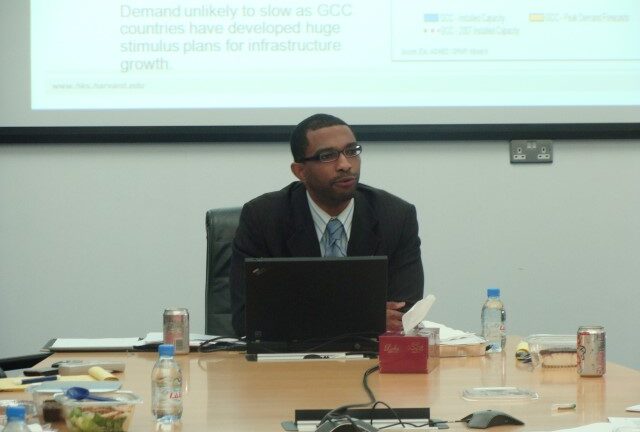Dialogue Series, Regional Studies
Gulf Gas Development: A Rational Development Strategy

On November 11, 2009, Justin Dargin, a Research Fellow with The Dubai Initiative at Harvard University and a Fulbright Scholar of the Middle East, was invited by CIRS to deliver a lecture on “Gulf Gas Development: A Rational Development Strategy” to Georgetown University in Qatar faculty and staff. The lecture focused on the basics of the Gulf Gas/Power Sector and how the countries of the GCC are facing the current energy challenges.
Dargin maintained that “the Gulf region is home to some of the largest natural gas reserves: 23% of global total” but because there is “only 8% of global production,” there is great future potential to tap into these reserves to facilitate increased production. Qatar, he said, is the world’s number one Liquid Natural Gas (LNG) exporter since 2006. “With the exception of Qatar,” Dargin noted, “every GCC member is facing a gas shortage.” By developing its natural gas sector, Qatar’s industrial development program rivals the traditional oil production projects of its neighbors.
Gulf Gas Development: A Rational Development Strategy from Georgetown University School of Foreign Service in Qatar
Over the last few decades, the Gulf states have experienced a tremendous injection of wealth to their local economies. This has had major effects on the infrastructure and population of the countries and all the related demands that these expansions entail. Currently, there is a “demographic explosion” of imported labor that far outstrips local populations and “a major push for industrialization” combined with a “need for desalination projects.” Because the GCC is growing at an unprecedented pace, various developments are needed to sustain the future of GCC infrastructure and economies. In this respect, Dargin argued that “the GCC will need to add 60 gigawatts (GW) of additional power between 2009 and 2015, which represents 80% of current capacity.”
Going through case studies for each Gulf state, Dargin pointed out how the “gas crunch” has affected these countries’ individual economies. Saudi Arabia is experiencing problems because “recent OPEC quotas prevented it from supplying additional gas to the domestic sector, thus increasing the reliance on liquid fuels,” and in Kuwait, the UAE and Oman, “there will not be enough gas to meet the demand increase,” argued Dargin.
The ramifications, Dargin noted, is that the domestic price paid for gas and electricity is too low, which “distorts investment and consumption decisions. It dampened interest for regional trading in favor of global LNG export.” He further added that “the main obstacle between the two regional suppliers, Iran and Qatar, and the regional consumers, Kuwait, UAE and Bahrain, has been pricing issues.”
Concluding the lecture with the future prospects of the energy sector in the GCC, Dargin said that there are, currently in the initiation phase, various ambitious projects being set up to exploit natural resources and to “stimulate domestic production.” Some of these initiatives include establishing domestic gas production facilities and investment in renewable and alternative energy plans such as “the GCC Nuclear plan, various solar and wind initiatives, and the Masdar Initiative.”
Dargin is a specialist in international law and energy law, and is a prolific author on energy affairs. He specializes in carbon trading, the global oil and gas market, the legal framework surrounding the Gulf energy sector, and Middle Eastern geopolitics. Dargin is the author of “The Dolphin Project: The Development of a Gulf Gas Initiative” (OIES Press January 2008), and the author of a book, entitled Desert Dreams: The Quest for Gulf Integration from the Arab Revolt to the Gulf Cooperation Council (forthcoming 2010).
Article by Suzi Mirgani, CIRS Publications Coordinator.